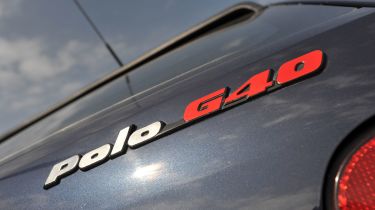Volkswagen Polo G40
We step back in time to see how the last supercharged Polo compares
The Polo G40 Coupé hit the UK in 1991, but if you haven’t heard of it, don’t be surprised. It wasn’t a sales success, as VW shifted only 616 in the four years it was available.
By modern standards, the 113bhp produced from its supercharged 1.3-litre engine is unimpressive, but combine that output with a short-ratio gearbox and lightweight construction – it tips the scales at less than a tonne – and you’ve got an entertaining hot hatch.
The first thing that strikes you about the G40 is its size. It’s so small it makes the latest Polo look like an MPV. The red bumper stripe and 13-inch BBS alloy wheels are very Nineties, but there’s still something pleasing about the simple overall shape. VW ambitiously referred to the G40 as a coupé, although as you can see in the pictures, it’s little more than a three-door hatchback.
At launch, the marketing men made a big thing about the premium switchgear, which was lifted directly from the Passat, and that quality is still evident today. The fixed wheel means the driving position isn’t as adjustable as its modern peers, but the sports seats are comfortable and supportive, despite their lurid fabric pattern.
Used - available now

2023 Audi
Q4 Sportback e-tron
54,526 milesAutomaticElectric
Cash £23,363
2022 Kia
Niro
18,315 milesAutomaticPetrol1.6L
Cash £17,900
2023 Nissan
Juke
40,858 milesManualPetrol1.0L
Cash £12,287
2022 Volkswagen
T-Roc
36,779 milesAutomaticPetrol1.5L
Cash £18,600The rest of the cabin lacks the design flair featured in today’s hot hatches, with acres of black plastic and basic instruments. Still, the thin pillars and large glass area make for a terrific view of the road, and the manual windows and sunroof keep the weight down. This is instantly noticeable on the road, where the G40 feels really light on its feet. The unassisted steering weights up mid-corner as the tiny tyres dig hard for grip. And even with the sports suspension, the large-profile tyres aid the ride, so it’s firm but comfortable.
Unlike its turbocharged peers, the boost provided by the supercharger comes low in the rev range, and the most impressive aspect of the whole set-up is its linear power delivery.
It’s eager to rev as well, a job made easier by the short-ratio five-speed gearbox, which is well weighted and precise. Even though it doesn’t feel as urgent as the Bocanegra or Polo GTI, there’s little reason to doubt the claimed 0-60mph time of 8.1 seconds – a figure that’s still quick by today’s standards.
It can’t keep up with its modern counterparts in a straight line, and the Nineties model isn’t as refined, either, but for driver involvement and a sense of occasion, it stands the test of time. And after driving cars laden with safety kit and clever electronics, the purity of the experience comes as a breath of fresh air.







